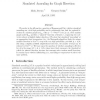Free Online Productivity Tools
i2Speak
i2Symbol
i2OCR
iTex2Img
iWeb2Print
iWeb2Shot
i2Type
iPdf2Split
iPdf2Merge
i2Bopomofo
i2Arabic
i2Style
i2Image
i2PDF
iLatex2Rtf
Sci2ools
FOCS
1993
IEEE
1993
IEEE
Simulated Annealing for Graph Bisection
We resolve in the a rmative a question of Boppana and Bui: whether simulated annealing can, with high probability and in polynomial time, nd the optimal bisection of a random graph in Gnpr when p?r = (n ?2) for 2. (The random graph model Gnpr speci es a \planted" bisection of density r, separating two n=2vertex subsets of slightly higher density p.) We show that simulated \annealing" at an appropriate xed temperature (i.e., the Metropolis algorithm) nds the unique smallest bisection in O(n2+" ) steps with very high probability, provided > 11=6. (By using a slightly modi ed neighborhood structure, the number of steps can be reduced to O(n1+" ).) We leave open the question of whether annealing is e ective for in the range 3=2 < 11=6, whose lower limit represents the threshold at which the planted bisection becomes lost amongst other random small bisections. It remains open whether hillclimbing (i.e., annealing at temperature 0) solves the same problem.
| Added | 08 Aug 2010 |
| Updated | 08 Aug 2010 |
| Type | Conference |
| Year | 1993 |
| Where | FOCS |
| Authors | Mark Jerrum, Gregory B. Sorkin |
Comments (0)

